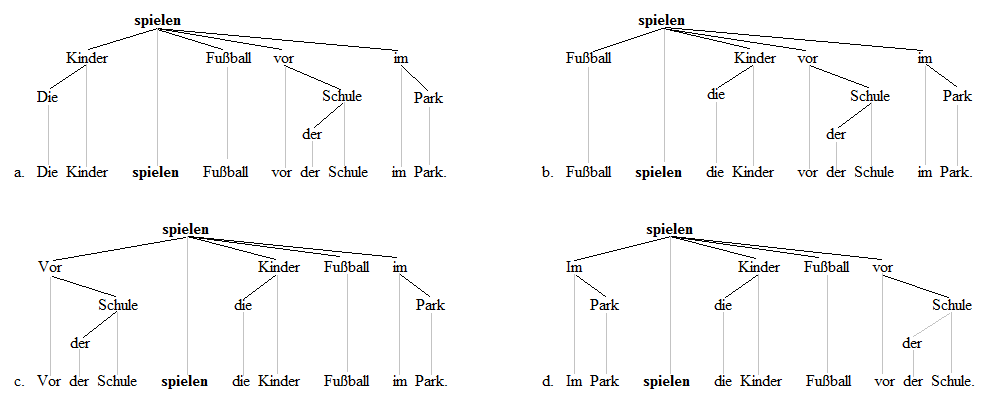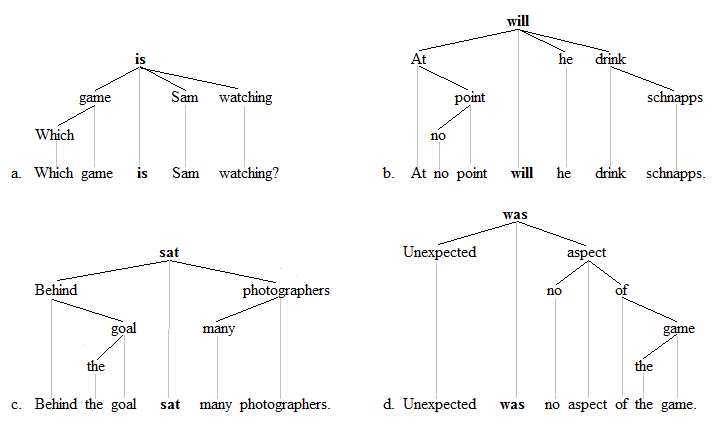English
Modern English differs greatly in word order from other modern Germanic languages, but earlier English shared many similarities. For this reason, some scholars propose a description of Old English with V2 constraint as the norm. The history of English syntax is thus seen as a process of losing the constraint. [17]
Old English
In these examples, finite verb forms are in green, non-finite verb forms are in orange and subjects are blue.
Main clauses
Se
the
mæssepreost
masspriest
sceal
shall
manum
people
bodian
preach
þone
the
soþan
true
geleafan
faith
'The mass priest shall preach the true faith to the people.'
Hwi
Why
wolde
would
God
God
swa
so
lytles
small
þinges
thing
him
him
forwyrman
deny
'Why would God deny him such a small thing?'
on
in
twam
two
þingum
things
hæfde
has
God
God
þæs
the
mannes
man's
sawle
soul
geododod
endowed
'With two things God had endowed man's soul.'
þa
then
wæs
was
þæt
the
folc
people
þæs
of-the
micclan
great
welan
prosperity
ungemetlice
excessively
brucende
partaking
'Then the people were partaking excessively of the great prosperity.'
Ne
not
sceal
shall
he
he
naht
nothing
unaliefedes
unlawful
don
do
'He shall not do anything unlawful.'
Ðas
these
ðreo
three
ðing
things
forgifð
gives
God
God
he
his
gecorenum
chosen
'These three things God gives to his chosen
Position of object
In examples b, c and d, the object of the clause precedes a non-finite verb form. Superficially, the structure is verb-subject-object- verb. To capture generalities, scholars of syntax and linguistic typology treat them as basically subject-object-verb (SOV) structure, modified by the V2 constraint. Thus Old English is classified, to some extent, as an SOV language. However, example a represents a number of Old English clauses with object following a non-finite verb form, with the superficial structure verb-subject-verb object. A more substantial number of clauses contain a single finite verb form followed by an object, superficially verb-subject-object. Again, a generalisation is captured by describing these as subject–verb–object (SVO) modified by V2. Thus Old English can be described as intermediate between SOV languages (like German and Dutch) and SVO languages (like Swedish and Icelandic).
Effect of subject pronouns
When the subject of a clause was a personal pronoun, V2 did not always operate.
forðon
therefore
we
we
sceolan
must
mid
with
ealle
all
mod
mind
&
and
mægene
power
to
to
Gode
God
gecyrran
turn
'Therefore, we must turn to God with all our mind and power
This section's factual accuracy is disputed .(May 2022) |
However, V2 verb-subject inversion occurred without exception after a question word or the negative ne, and with few exceptions after þa even with pronominal subjects.
for
for
hwam
what
noldest
not-wanted
þu
you
ðe sylfe
yourself
me
me
gecyðan
make-known
þæt...
that...
'wherefore would you not want to make known to me yourself that...'
Ne
not
sceal
shall
he
he
naht
nothing
unaliefedes
unlawful
don
do
'He shall not do anything unlawful.'
þa
then
foron
sailed
hie
they
mid
with
þrim
three
scipum
ships
ut
out
'Then they sailed out with three ships.'
Inversion of a subject pronoun also occurred regularly after a direct quotation. [18]
"Me
to me
is,"
is
cwæð
said
hēo
she
Þīn
your
cyme
coming
on
in
miclum
much
ðonce"
thankfulness
'"Your coming," she said, "is very gratifying to me".'
Embedded clauses
Embedded clauses with pronoun subjects were not subject to V2. Even with noun subjects, V2 inversion did not occur.
...þa ða
...when
his
his
leorningcnichtas
disciples
hine
him
axodon
asked
for
for
hwæs
whose
synnum
sins
se
the
man
man
wurde
became
swa
thus
blind
blind
acenned
'...when his disciples asked him for whose sins the man was thus born blind'
Yes–no questions
In a similar clause pattern, the finite verb form of a yes–no question occupied the first position
Truwast
trust
ðu
you
nu
now
þe
you
selfum
self
and
and
þinum
your
geferum
companions
bet
better
þonne
than
ðam
the
apostolum...?
apostles
'Do you now trust yourself and your companions better than the apostles...?'
Middle English
Continuity
Early Middle English generally preserved V2 structure in clauses with nominal subjects.
On
in
þis
this
gær
year
wolde
wanted
þe
the
king
king
Stephne
Stephen
tæcen
seize
Rodbert
Robert
'During this year King Stephen wanted to seize Robert.'
Nu
now
loke
look
euerich
every
man
man
toward
to
himseleun
himself
'Now it's for every man to look to himself.'
As in Old English, V2 inversion did not apply to clauses with pronoun subjects.
bi
by
þis
this
ȝe
you
mahen
may
seon
see
ant
and
witen...
know
alle
all
ðese
those
bebodes
commandments
ic
I
habbe
have
ihealde
kept
fram
from
childhade
childhood
Change
Late Middle English texts of the fourteenth and fifteenth centuries show increasing incidence of clauses without the inversion associated with V2.
sothely
Truly
se
the
ryghtwyse
righteous
sekys
seeks
þe
the
loye
joy
and...
and...
And
And
by
by
þis
this
same
same
skyle
skill
hop
hope
and
and
sore
sorrow
shulle
shall
jugen
judge
us
us
Negative clauses were no longer formed with ne (or na) as the first element. Inversion in negative clauses was attributable to other causes.
why
why
ordeyned
ordained
God
God
not
not
such
such
ordre
order
'Why did God not ordain such an order?' (not follows noun phrase subject)
why
why
shulde
should
he
he
not...
not
(not precedes pronoun subject)
Ther
there
nys
not-is
nat
not
oon
one
kan
can
war
aware
by
by
other
other
be
be
'There is not a single person who learns from the mistakes of others'
He
He
was
was
despeyred;
in despair;
no thyng
nothing
dorste
dared
he
he
seye
say
Vestiges in Modern English
As in earlier periods, Modern English normally has subject-verb order in declarative clauses and inverted verb-subject order [19] in interrogative clauses. However these norms are observed irrespective of the number of clause elements preceding the verb.
Classes of verbs in Modern English: auxiliary and lexical
Inversion in Old English sentences with a combination of two verbs could be described in terms of their finite and non-finite forms. The word which participated in inversion was the finite verb; the verb which retained its position relative to the object was the non-finite verb. In most types of Modern English clause, there are two verb forms, but the verbs are considered to belong to different syntactic classes. The verbs which participated in inversion have evolved to form a class of auxiliary verbs which may mark tense, aspect and mood; the remaining majority of verbs with full semantic value are said to constitute the class of lexical verbs. The exceptional type of clause is that of declarative clause with a lexical verb in a present simple or past simple form.
Questions
Like Yes/No questions, interrogative Wh- questions are regularly formed with inversion of subject and auxiliary. Present Simple and Past Simple questions are formed with the auxiliary do, a process known as do-support.
a. Which game is Sam watching? b. Where does she live? - (see subject-auxiliary inversion in questions)
With topic adverbs and adverbial phrases
In certain patterns similar to Old and Middle English, inversion is possible. However, this is a matter of stylistic choice, unlike the constraint on interrogative clauses.
negative or restrictive adverbial first
c. At no point will he drink Schnapps. d. No sooner had she arrived than she started to make demands. - (see negative inversion)
comparative adverb or adjective first
e. So keenly did the children miss their parents, they cried themselves to sleep. f. Such was their sadness, they could never enjoy going out.
After the preceding classes of adverbial, only auxiliary verbs, not lexical verbs, participate in inversion
locative or temporal adverb first
g. Here comes the bus. h. Now is the hour when we must say goodbye.
prepositional phrase first
i. Behind the goal sat many photographers. j. Down the road came the person we were waiting for. - (see locative inversion, directive inversion)
After the two latter types of adverbial, only one-word lexical verb forms (Present Simple or Past Simple), not auxiliary verbs, participate in inversion, and only with noun-phrase subjects, not pronominal subjects.
Direct quotations
When the object of a verb is a verbatim quotation, it may precede the verb, with a result similar to Old English V2. Such clauses are found in storytelling and in news reports.
k. "Wolf! Wolf!" cried the boy. l. "The unrest is spreading throughout the country," writes our Jakarta correspondent. - (see quotative inversion)
Declarative clauses without inversion
Corresponding to the above examples, the following clauses show the normal Modern English subject-verb order.
Declarative equivalents
a′. Sam iswatching the Cup games. b′. She lives in the country.
Equivalents without topic fronting
c′. He will at no point drink Schnapps. d′. She had no sooner arrived than she started to make demands. e′. The children missed their parents so keenly that they cried themselves to sleep. g′. The bus iscoming here. h′. The hour when we must say goodbye is now. i′. Many photographers sat behind the goal. j′. The person we were waiting for came down the road. k′. The boy cried "Wolf! Wolf!" l′. Our Jakarta correspondent writes, "The unrest is spreading throughout the country" .


